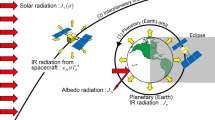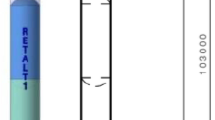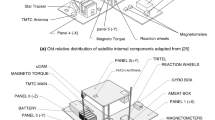Abstract
Steerable antennas are widely used for Satellite communications. A steerable reflector array antenna is designed to meet in-flight reconfigurability requirements for space applications such as minimized interference and production of fixed spot beams on the ground from an LEO/GEO Satellite. Indian communication Spacecraft in the discussion was being realized as an exclusive communication satellite catering to user service requirements in Ku-band. It has four Ku-band offset-shaped steerable reflectors of 0.6 m aperture diameter. Normally any deploying/moving mechanism needs a hold-down mechanism to resist the launch loads. Any type of hold-down mechanism requires a release actuator and such a dedicated hold-down system requires both mechanical and electrical resources which means increased mass and power requirements. Hence, a separate launch hold-down requirement is also eliminated by moving the mechanism to the dead centre position. The steering mechanism consists of an input link and an output link connected by a coupler link. Antenna is connected to the output link. The input link is driven by a motor. The link lengths are selected such that the output link oscillates by a known angle for specified rotation of the input link through kinematic analysis. When the motor is operated, the input link rotates and in turn moves the output link up and down about the main bearing axis thereby steering the antenna with high accuracy. This paper presents the concept and design details of the novel steering mechanism incorporating a four-bar linkage for steering through small angles ranging from \(0^\circ\) to 5\(^\circ\) and back. Additionally, details of hardware realization, performance evaluation through ground testing and on-orbit performance summary are also provided.



























Similar content being viewed by others
Data availability
Data that supports the findings of the study is available within ISRO servers at 10.21.6.100:9088/smg. This has restricted access.
Abbreviations
- AHSM:
-
Antenna hold down and steering mechanism
- APM:
-
Antenna pointing mechanism
- DOF:
-
Degree of freedom
- GD&T:
-
Geometric dimensioning & Tolerancing
- TVAC:
-
Thermo vacuum
- ADE:
-
Antenna drive electronics
- FMECA:
-
Failure Modes, Effects and criticality Analysis
- LEO:
-
Low earth orbit
- GEO:
-
Geostationary orbit
- EF:
-
Earth facing
- SHF:
-
Super high frequency
- TAS-I:
-
Thales Alenia Space Italia
- MEMS:
-
Micro electro-mechanical systems
- RF:
-
Radiofrequency
- ESA:
-
European space agency
- CFRP:
-
Carbon Fiber Reinforced Plastic
- MLI:
-
Multi-Layer insulation
- GFRP:
-
Glass fibre reinforced Plastic
- MOS2:
-
Molybdenum Disulphide
- FRP:
-
Fibre reinforced Plastic
- ADC:
-
Analog to digital converter
- TM:
-
Telemetry
- FPGA:
-
Field-programmable gate Array
- VHDL:
-
VHSIC Hardware Description Language
- QSL:
-
Quasi Static Load
- FE:
-
Finite Element
- FM:
-
Flight model
- DM:
-
Developmental model
- ETLS:
-
Environmental Test Level specifications
- CW:
-
Clockwise
- CCW:
-
Counter clockwise
- IOT:
-
Initial orbit testing
References
Klahn, R., Norton, J.A., Githens, J.A.: Antenna steering system. Bell Syst. Tech. J. 40(4), 1207–1225 (1961). https://doi.org/10.1002/j.1538-7305
Capece, P., Carati, P., Contu, S., Maiarelli, D., Mizzoni, R., Noschese, P., Trento, R. and Valle, P., Array Technology in Thales Alenia Space Italia. In 2009 3rd European Conference on Antennas and Propagation, IEEE, 2009, pp : 783–787
Legay, Herve, Pinte, B., Charrier, M., Zaiei, A., Girard, E. and Gillard, R.: A steerable reflectarray antenna with MEMS controls. IEEE International Symposium on Phased Array Systems and Technology, 2003. IEEE, 2003, pp : 494–499
Hu, B.B., Justin, T.D., Zhang, X.-C., Auston, D.H., Smith, P.R.: Optically steerable photoconducting antennas. Appl. Phys. Lett. 56(10), 886–888 (1990)
Ferris M, Phillips N: The use and advancement of an affordable adaptable antenna pointing mechanism. Proc. 14th Eur. Space Mech. Tribol. Symp, 2011, pp: 227–234
Vázquez J, Pinto I, Gabiola I, Ibargoyen I, Martin F, Sener ingenieria y sistemas, avda zugazarte.:Antenna pointing mechanisms for solar orbiter high and medium gain antennas, 56 getxo spain, email: jorge.vazquez@sener.es
St-Andre S, Dumais M-C, Lebel L-P, Langevin J-P, Horth R, Winton A, Lebleu D.:Development and qualification of an antenna pointing mechanism for the Exomars high-gain antenna. MDA, 21025 Transcanada highway, ste-anne, h9x 3r2, Canada, email: stephane.st-andre@mdacorporation.com, esa/estec, keplerlaan 1, postbus 299, 2200 ag, Noordwijk, nl, email: alistair.winton@esa.int, tas france,5 allée des gabians - 06156 Cannes la bocca, France , email: denis.lebleu@thalesaleniaspace.com
Li Q, Wan S, Zhang key L.:Design of pointing control mechanism for spacecraft antenna communication”, Laboratory of space utilization, Technology and engineering center for space utilization, Chinese academy of Sciences, Beijing 100094
Andreou S, Papadopoulos EG.:Design of a reactionless pointing mechanism for satellite antennas. National Technical University of Athens Department of Mechanical Engineering–Control Systems Laboratory 9, Heroon Polytehneiou Str., 15780, Athens, Greece e-mail: egpapado@central.ntua.gr
Wallis RE, Cheng S.:Phased-Array Antenna System for the MESSENGER Deep Space Mission1. The Johns Hopkins University, Applied Physics Laboratory,11100 Johns Hopkins Rd, Laurel MD, 20723240-228-3836
Murakami BT, Ohta AT, Tamamoto MA, Shiroma GS, Miyamoto RY, Shiroma WA.:Self-Steering Antenna Arrays for Distributed Picosatellite Networks. University of Hawaii at Manoa Department of Electrical Engineering 2540 Dole St., Holmes Hall 483 Honolulu, HI 96822 Voice: 808–956–7218, E-mail: murakam@eng.hawaii.edu
Li Z, Ahmed E, Eltawil AM.:Beam-Steering Reconfigurable Antenna for WLAN Applications. Senior Member, IEEE, and Bedri A. Cetiner, Member, IEEE
Murer JA, Harper R, Anderson M.:High temperature antenna pointing mechanism for BEPICOLOMBO mission. Kongsberg Defence and Aerospace (KDA), PO 1003, N-3601 Kongsberg, Norway, email: johan.a.murer@kongsberg.com (BAE systems, Advanced Technology Centre, Gt Baddow, Chelmsford, Essex, UK, CM2 0DT, email: richard.harper@baesystems.com, ESTL, AEA Technology, Darwin House, 414 The Quadrant, Birchwood Park, Warrington, Cheshire, WA3 6AT, UK, email: mike.Anderson@aeat.co.uk
Kamboj S, Dahiya R.:Adaptive Antenna Array for Satellite Communication Systems”, Proceedings of the International Multi Conference of Engineers and Computer Scientists, 2008, Vol II, IMECS 2008, 19–21 March, 2008, Hong Kong
Tang QI, Mcguyer BH, Booen E, Saraswat S, Tabatabai F, Bolandhemmat H, Von Badinski C, Theunissen WH.:Flat-Panel Mechanical Beam Steerable Array Antennas With In-Plane Rotations: Theory, Design and Low-Cost Implementation. Facebook Inc., Menlo Park, CA 94025, USA SpaceX Co., Hawthorne, CA 90250, USA
Shin JY, Park CH, Woo JM.:Design of Microstrip Antenna for Satellite Navigation System Jamming. Department of Radio and Information Communications Engineering Chungnam National University, Daejeon, 34134, Korea
Huang J.:Spacecraft Antenna Research and Development Activities Aimed at Future Missions
Eiden M, Seiler R.:Space mechanisms and tribology challenges of future space missions. Mechanical Engineering Department, European Space Agency (ESA/ESTEC), P.O. Box 299, NL-2200 AG Noordwijk, The Netherlands
Cheng Y, Song N, Roemer F, Henniger MHH, Metzig R, Diedrich E.:Satellite Ground Stations with Electronic Beam Steering Communications. Research Laboratory Ilmenau, University of Technology Ilmenau, Germany, German Aerospace Center (DLR), Oberpfaffenhofen, Germany {Hennes.Henniger, Robert.Metzig, erhard.diedrich}@dlr.de
Aliakbarian H, Van Der Westhuizen E, Wiid R, Volskiy V, Wolhuter R, Vandenbosch GAE.:An Efficient Beam Steerable Antenna Array Concept for Airborne Applications” Esat-Telemic, KU Leuven, Kasteelpark Arenberg, 10 3001, Leuven, Belgium, E&E Engineering Dept., Banghoek Road, Stellenbosch University, Stellenbosch, 7600, South Africa, Dept. of ECE, K.N.Toosi University of Technology, Tehran, Iran h.aliakbarian@ieee.org, ewaldvdw@sun.ac.za
Acknowledgements
Authors would like to acknowledge the support towards alignment and implementation of the thermal blanket and related elements from the alignment division and thermal implementation division, URSC. They would also like to thank the Special Mechanisms Review Committee, SMG and other senior colleagues for their valuable inputs during the internal reviews. They thank DD, MSA, and Director, URSC for their constant support and encouragement.
Funding
The author(s) received no financial support for the research, authorship, and/or publication of this article.
Author information
Authors and Affiliations
Corresponding author
Ethics declarations
Conflict of interest
The author(s) declared no potential conflicts of interest with respect to the research, authorship, and/or publication of this article.
Additional information
Publisher's Note
Springer Nature remains neutral with regard to jurisdictional claims in published maps and institutional affiliations.
Patent bearing registration no. 393573 has been granted in accordance with the provisions of the Patents act, 1970 in respect of patent application no. 201641030507 dated 07.09.2016 by Controller of Patents, Govt. of India. Title of the patent is ‘‘A Novel Antenna steering mechanism with self hold down feature for communication spacecrafts’’.
Rights and permissions
Springer Nature or its licensor (e.g. a society or other partner) holds exclusive rights to this article under a publishing agreement with the author(s) or other rightsholder(s); author self-archiving of the accepted manuscript version of this article is solely governed by the terms of such publishing agreement and applicable law.
About this article
Cite this article
Kapoor, A., Nagaraj, B.P., Kumar, A. et al. A novel antenna steering mechanism with self hold-down feature for communication spacecrafts. CEAS Space J 16, 285–306 (2024). https://doi.org/10.1007/s12567-023-00496-x
Received:
Revised:
Accepted:
Published:
Issue Date:
DOI: https://doi.org/10.1007/s12567-023-00496-x




